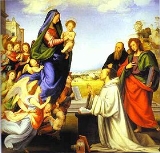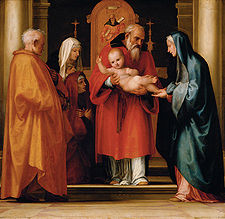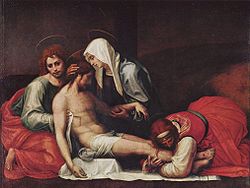
Fra Bartolommeo
Encyclopedia
Fra Bartolomeo or Fra Bartolommeo (di Pagholo) (March 28, 1472 – October 6, 1517), also known as Baccio della Porta, was an Italian
Renaissance
painter of religious subjects.
. He received the nickname of Baccio della Porta for his house was near the Porta ("Gate") San Pier Gattolini.
Starting from 1483 or 1484, by recommendation of Benedetto da Maiano
, he apprenticed in the workshop of Cosimo Rosselli
. He was one of the greatest painters of his time. In 1490 or 1491 he began a collaboration with Mariotto Albertinelli
. In the late 1490s Baccio was drawn to the teachings of Fra Girolamo Savonarola
, who denounced what he viewed as vain and corrupt contemporary art. Savonarola argued for art serving as a direct visual illustration of the Bible
to educate those unable to read the book. From 1498 is his famous portrait of Savonarola, now in the Museo Nazionale di San Marco in Florence. The following year he was commissioned a fresco of the Universal Judgement for the Ospedale di Santa Maria Nuova, completed by Albertinelli and Giuliano Bugiardini
when Baccio became a Dominican
friar
on July 26, 1500. The following year he entered the convent of San Marco.
He renounced painting for several years, not resuming until 1504 when he became the head of the monastery workshop in obedience to his superior. In that year he began a Vision of St. Bernard for Bernardo Bianco's family chapel in the Badia Fiorentina
, finished in 1507.
Soon thereafter, Raphael
visited Florence and befriended the friar. Bartolomeo learned perspective from the younger artist, while Raphael added skills in coloring and handling of drapery, which was noticeable in the works he produced after their meeting. With Raphael, he remained on the friendliest terms, and when he departed from Rome, left in his hands two unfinished pictures which Raphael completed.
At the beginning of 1508 Bartolomeo moved to Venice
to paint a Holy Father, St. Mary Magdalene and St. Catherine of Siena for the Dominicans of San Pietro Martire in Murano
, influenced somewhat by Venetian colorism. As the Dominicans did not pay the work, he took it back to Lucca
, where it can be seen now. Also in Lucca, in the October 1509, he painted by Albertinelli an altarpiece with Madonna and Child with Saints for the local cathedral. On November 26, 1510 Pier Soderini commissioned him an altarpiece for the Sala del Consiglio of Florence, now in the Museum of San Marco. Two years later he finished another altarpiece for the cathedral of Besançon
.
 In 1513 he went to Rome, where he painted a Peter and Paul, now in the Pinacoteca Vaticana, while from the following years are the St. Mark Evangelist
In 1513 he went to Rome, where he painted a Peter and Paul, now in the Pinacoteca Vaticana, while from the following years are the St. Mark Evangelist
of Palazzo Pitti
in Florence and the frescoes in the Dominican convent of Pian di Mugnone. After a promised Feast of Venus for Duke Alfonso I d'Este
of Ferrara
, of which only drawings remain, his last work is fresco of Noli me tangere
also in Pian di Mugnone.
He died in Florence in 1517.
 Initially, his works showed the influence of Rosselli's assistant, Piero di Cosimo
Initially, his works showed the influence of Rosselli's assistant, Piero di Cosimo
, and those of Domenico Ghirlandaio
and Filippino Lippi
. After his hiatus from 1500 to 1503, he seemed to change vision, taking from Raphael the representation of light and its effects over moving shapes.
Fra Bartolomeo's figures are generally small and draped. These qualities were alleged against him as defects, and to prove that his style was not the result of want of power, he painted the magnificent figure of the St. Mark Evangelist (ranked as his masterpiece), and the undraped figure of St. Sebastian. It is alleged that the latter was felt to be so strongly expressive of suffering and agony, that it was found necessary to remove it from the place where it had been exhibited in the chapel of a convent.
Fra Bartolomeo's compositions are remarkable for skill in the massing of light and shade, richness and delicacy of colouring, and for the admirable drapery of the figures, Bartolomeo having been the first to introduce and use the lay-figure with joints.
Italian people
The Italian people are an ethnic group that share a common Italian culture, ancestry and speak the Italian language as a mother tongue. Within Italy, Italians are defined by citizenship, regardless of ancestry or country of residence , and are distinguished from people...
Renaissance
Renaissance
The Renaissance was a cultural movement that spanned roughly the 14th to the 17th century, beginning in Italy in the Late Middle Ages and later spreading to the rest of Europe. The term is also used more loosely to refer to the historical era, but since the changes of the Renaissance were not...
painter of religious subjects.
Biography
He was born in Savignano di Prato, TuscanyTuscany
Tuscany is a region in Italy. It has an area of about 23,000 square kilometres and a population of about 3.75 million inhabitants. The regional capital is Florence ....
. He received the nickname of Baccio della Porta for his house was near the Porta ("Gate") San Pier Gattolini.
Starting from 1483 or 1484, by recommendation of Benedetto da Maiano
Benedetto da Maiano
Benedetto da Maiano was an Italian sculptor of the early Renaissance.Born in the village of Maiano , he started his career as companion of his brother, the architect Giuliano da Maiano. When he reached the age of thirty he started training under the sculptor Antonio Rossellino...
, he apprenticed in the workshop of Cosimo Rosselli
Cosimo Rosselli
Cosimo Rosselli was an Italian painter of the Quattrocento, active mainly in his birthplace of Florence.-Biography:Born in Florence, at the age of fourteen he became a pupil of Neri di Bicci, and in 1460 he worked as assistant to his cousin Bernardo di Stefano Rosselli...
. He was one of the greatest painters of his time. In 1490 or 1491 he began a collaboration with Mariotto Albertinelli
Mariotto Albertinelli
Mariotto di Bigio di Bindo Albertinelli was a High Renaissance Italian painter of the Florentine school, closely involved with Fra Bartolomeo and influenced by Raphael.-Biography:Mariotto Albertinelli was born in Florence...
. In the late 1490s Baccio was drawn to the teachings of Fra Girolamo Savonarola
Girolamo Savonarola
Girolamo Savonarola was an Italian Dominican friar, Scholastic, and an influential contributor to the politics of Florence from 1494 until his execution in 1498. He was known for his book burning, destruction of what he considered immoral art, and what he thought the Renaissance—which began in his...
, who denounced what he viewed as vain and corrupt contemporary art. Savonarola argued for art serving as a direct visual illustration of the Bible
Bible
The Bible refers to any one of the collections of the primary religious texts of Judaism and Christianity. There is no common version of the Bible, as the individual books , their contents and their order vary among denominations...
to educate those unable to read the book. From 1498 is his famous portrait of Savonarola, now in the Museo Nazionale di San Marco in Florence. The following year he was commissioned a fresco of the Universal Judgement for the Ospedale di Santa Maria Nuova, completed by Albertinelli and Giuliano Bugiardini
Giuliano Bugiardini
Giuliano Bugiardini was an Italian painter of the late-Renaissance period known as Mannerism, active mainly in Florence....
when Baccio became a Dominican
Dominican Order
The Order of Preachers , after the 15th century more commonly known as the Dominican Order or Dominicans, is a Catholic religious order founded by Saint Dominic and approved by Pope Honorius III on 22 December 1216 in France...
friar
Friar
A friar is a member of one of the mendicant orders.-Friars and monks:...
on July 26, 1500. The following year he entered the convent of San Marco.
He renounced painting for several years, not resuming until 1504 when he became the head of the monastery workshop in obedience to his superior. In that year he began a Vision of St. Bernard for Bernardo Bianco's family chapel in the Badia Fiorentina
Badia Fiorentina
The Badìa Fiorentina is an abbey and church now home to the Fraternity of Jerusalem situated on the Via del Proconsolo in the centre of Florence, Italy. Dante supposedly grew up across the street in what is now called the 'Casa di Dante', rebuilt in 1910 as a museum to Dante...
, finished in 1507.
Soon thereafter, Raphael
Raphael
Raffaello Sanzio da Urbino , better known simply as Raphael, was an Italian painter and architect of the High Renaissance. His work is admired for its clarity of form and ease of composition and for its visual achievement of the Neoplatonic ideal of human grandeur...
visited Florence and befriended the friar. Bartolomeo learned perspective from the younger artist, while Raphael added skills in coloring and handling of drapery, which was noticeable in the works he produced after their meeting. With Raphael, he remained on the friendliest terms, and when he departed from Rome, left in his hands two unfinished pictures which Raphael completed.
At the beginning of 1508 Bartolomeo moved to Venice
Venice
Venice is a city in northern Italy which is renowned for the beauty of its setting, its architecture and its artworks. It is the capital of the Veneto region...
to paint a Holy Father, St. Mary Magdalene and St. Catherine of Siena for the Dominicans of San Pietro Martire in Murano
Murano
Murano is a series of islands linked by bridges in the Venetian Lagoon, northern Italy. It lies about 1.5 km north of Venice and measures about across with a population of just over 5,000 . It is famous for its glass making, particularly lampworking...
, influenced somewhat by Venetian colorism. As the Dominicans did not pay the work, he took it back to Lucca
Lucca
Lucca is a city and comune in Tuscany, central Italy, situated on the river Serchio in a fertile plainnear the Tyrrhenian Sea. It is the capital city of the Province of Lucca...
, where it can be seen now. Also in Lucca, in the October 1509, he painted by Albertinelli an altarpiece with Madonna and Child with Saints for the local cathedral. On November 26, 1510 Pier Soderini commissioned him an altarpiece for the Sala del Consiglio of Florence, now in the Museum of San Marco. Two years later he finished another altarpiece for the cathedral of Besançon
Besançon
Besançon , is the capital and principal city of the Franche-Comté region in eastern France. It had a population of about 237,000 inhabitants in the metropolitan area in 2008...
.

Mark the Evangelist
Mark the Evangelist is the traditional author of the Gospel of Mark. He is one of the Seventy Disciples of Christ, and the founder of the Church of Alexandria, one of the original four main sees of Christianity....
of Palazzo Pitti
Palazzo Pitti
The Palazzo Pitti , in English sometimes called the Pitti Palace, is a vast mainly Renaissance palace in Florence, Italy. It is situated on the south side of the River Arno, a short distance from the Ponte Vecchio...
in Florence and the frescoes in the Dominican convent of Pian di Mugnone. After a promised Feast of Venus for Duke Alfonso I d'Este
Alfonso I d'Este
Alfonso d'Este was Duke of Ferrara during the time of the War of the League of Cambrai.-Biography:He was the son of Ercole I d'Este and Leonora of Naples....
of Ferrara
Ferrara
Ferrara is a city and comune in Emilia-Romagna, northern Italy, capital city of the Province of Ferrara. It is situated 50 km north-northeast of Bologna, on the Po di Volano, a branch channel of the main stream of the Po River, located 5 km north...
, of which only drawings remain, his last work is fresco of Noli me tangere
Noli me tangere
Noli me tangere, meaning "don't touch me" / "touch me not", is the Latin version of words spoken, according to , by Jesus to Mary Magdalene when she recognizes him after his resurrection....
also in Pian di Mugnone.
He died in Florence in 1517.
Evaluation

Piero di Cosimo
Piero di Cosimo , also known as Piero di Lorenzo, was an Italian Renaissance painter.-Biography:The son of a goldsmith, Piero was born in Florence and apprenticed under the artist Cosimo Rosseli, from whom he derived his popular name and whom he assisted in the painting of the Sistine Chapel in...
, and those of Domenico Ghirlandaio
Domenico Ghirlandaio
Domenico Ghirlandaio was an Italian Renaissance painter from Florence. Among his many apprentices was Michelangelo.-Early years:Ghirlandaio's full name is given as Domenico di Tommaso di Currado di Doffo Bigordi...
and Filippino Lippi
Filippino Lippi
Filippino Lippi was an Italian painter working during the High Renaissance in Florence, Italy.-Biography:...
. After his hiatus from 1500 to 1503, he seemed to change vision, taking from Raphael the representation of light and its effects over moving shapes.
Fra Bartolomeo's figures are generally small and draped. These qualities were alleged against him as defects, and to prove that his style was not the result of want of power, he painted the magnificent figure of the St. Mark Evangelist (ranked as his masterpiece), and the undraped figure of St. Sebastian. It is alleged that the latter was felt to be so strongly expressive of suffering and agony, that it was found necessary to remove it from the place where it had been exhibited in the chapel of a convent.
Fra Bartolomeo's compositions are remarkable for skill in the massing of light and shade, richness and delicacy of colouring, and for the admirable drapery of the figures, Bartolomeo having been the first to introduce and use the lay-figure with joints.

